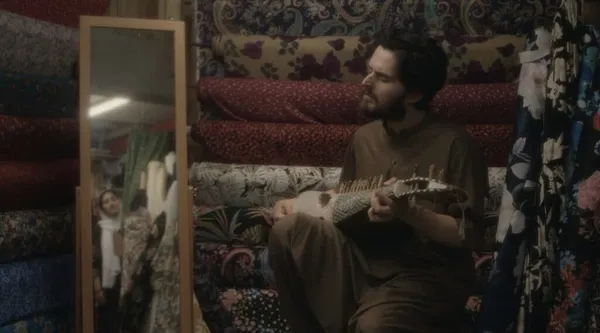 |
| Elham Ehsas in Yellow |
It’s a bright, sunny day when I speak with Elham Ehsas. He’s relaxing outside in the centre of London, four and a half thousand miles from where he was born, but Afghanistan is still very much in his heart. He’s recently directed and starred in a short film, Yellow, which depicts an encounter between a Talib shopkeeper and a young woman who has come in to buy her first, now obligatory, chadari, the garment without which she will no longer be allowed to go outside. At the time of publication, it has just screened at the Palm Springs Short Film Festival, one of the most prestigious short film showcases in the world, and it’s heading for London as part of Refugee Week. Elham and I begin our conversation by talking about his own experience of leaving Afghanistan and growing up in the UK.
“I left Afghanistan at a time in my life when I was turning into into a man. I was changing, I was finding my identity,” he says. “So it's almost like I didn't leave too early to forget, but I didn’t leave so late that I couldn't change. Ever since I've been juggling between the West and the East, having grown up in London, but having left Afghanistan. But in who my work is for my story and what I've been interested in, I've always orbited my country. I've always been drawn to Afghanistan.
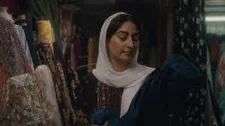 |
| Afsaneh Dehrouyeh in Yellow |
“I'm quite in touch, and in fact, I just got back three days ago. I went just to see it again. I'm always up to date, watching the news, following it on social media, on YouTube. Seeing what the country is going through. And it's a strange land, because since I've been born, the country's flag has changed 19 times, which is insane. And having just come back again, it was an incredible experience. But the country is on its knees. So I decided to dedicate my life, in terms of telling stories, to bringing things to life on the western screen that we don't usually see.”
Outsiders often focus on the restrictions forced upon Afghan women, as this film does, but isn’t there also a huge issue with poverty there at the moment?
“Oh, absolutely. The government has had all its funds frozen. There's no aid coming in. The UN is on the brink of pulling out. It's facing a massive humanitarian crisis. Like I said, it's it's a country on its knees at the moment, which is heartbreaking because it's been at war for the best part of four decades now. Being there and seeing the country go through what it is just makes me sad, because on the one hand, I'm proud to be Afghan, but on the other side I’m in Wembley, I can see highrises and I'm thinking, why isn't my country like this?”
Early on in the film we are confronted by the sight of the chadaris, but when we move into the back part of the shop, there's traditional music, and there's traditional clothing and things that are originally Afghan and not the traditions that the Taliban claim are all of Afghanistan's history. Was it very important to him to be able to tell that part of the story?
He nods. “When planning the film, I was really keen to make sure that both the blocking – the camera moves – and the production design speak to each other. So when she walks in, we have a smaller screen, and these chadaris, the veils, kind of overpowering her. Hauntingly so. And then the deeper she goes into the shop, you notice there's more colour, just to show that the country is a country full of colour, but it's being hidden. That was kind of a subtle thing that I was aiming at.”
Sadly, that part of Afghanistan is hidden away now, in so much that people in the West forget about it and don't realise it's there, and think of what the Taliban have done as being normal for Afghanistan
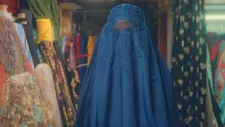 |
| Afsaneh Dehrouyeh in a chadari |
“That was actually part of the reason why I started telling stories and making films about Afghanistan,” he says. “Just because my country has so much colour and so much life and vibrancy. Even being in Kabul, I could see the women who are wearing yellow that is under the chadaris; I could see their anklets. I could catch glimpses of the colours that they're wearing underneath – it’s almost a protest. They're almost protesting under the chadari as well, which is what I tried to do with the dance sequence in the film, where it's kind of like a roar in her own way. You know, just like her screaming out.”
I tell him that, I liked that sequence because it has so much emotion in it, but also because she seems to be trying to bring the fabric to life or to say something with the fabric by giving it energy.
“She's almost using what she's being imprisoned by to make art. You know, using that to speak out and express herself, which is tragic, but also beautiful in a way. I thought it was. When I write, oftentimes I hit brick walls, but I remember when I was writing the scene that came to be the dance sequence, there was the biggest moment of ‘Hallelujah!’ Like, I've unlocked it, I figured it out, I know the missing pieces. It fit right in.”
I also like the light-hearted interactions between the two characters in the film, because they show that human potential, which is then taken away at the end.
“I was really keen to show – because the shopkeeper is a Taliban himself – to show that both Laili, the girl, and the shopkeeper, they're both bound by different handcuffs. And they're both trapped. In a different country, in a different life, they could have been lovers or really good friends, you know? Because there is chemistry there, but there's an invisible wall between the two, which I found interesting. Laili is trapped by this veil of oppression but the Talib shopkeeper is also stuck because of this history or in this culture of what the Taliban represent. You know, he shouldn't be playing a rubab, but he just can’t help being drawn to art. So that's what I tried to do, I tried to add a bit of subtlety to it. It's never black or white, you know, it's a bit more nuanced than that in real life.”
There’s also a wonderful conversation about colours, and the English words for colours, which allows for that sort of flirting but also shows us that she's an educated person, and that she has something to offer that level, which is going to be lost under the Taliban.
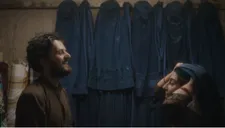 |
| Elham Ehsas and Afsaneh Dehrouyeh in Yellow |
“That's exactly it, because the schools are shut down. Girls who are close to graduating, who have studied for the last two decades, three decades, in Afghanistan, now that's all taken away from them. So the fact that Laili is more educated than the shopkeeper is even more tragic. Because now all of that talent and potential in life, is just hidden under the new cloak. So that's another lesson, another layer that I tried to show,.
“I sat with my mum in May last year, and that's when I watched the actual Taliban press conference. What we see in the film is what I actually saw, and then later on, I bought the rights to that clip. But that's what I saw, and I was like, ‘Wow, there are women who grew up when the Taliban weren’t around, and they've never had to wear this veil. But now they have to go and buy the veil for the first time. I wonder what that feels like?
“That's when I was like, ‘Ah, I wonder if that's something interesting to write about?’ What if this girl that goes in there, she's never worn one before? How would that play out? You know, so I just asked myself questions, and then I just found myself floating to my desk. As I opened my laptop it flooded out and I knew I knew instantly that I wanted to make it. As soon as the idea came to me, I was like, ‘Right, I have my next film. This is what I'm going to make sure I do.’
“What I tried to do with the framing, with my images, in the cinematography is to try and make the chadaris a character on their own, and I tried to make them as scary as possible because that's what they are. They are scary. You can barely see anything. I remember when I got them sent over from Afghanistan I wore them myself just to see what you can see. There's no access to your peripheral vision, which makes walking a nightmare. It completely shuts you out. And it not only physically touches your life in a bad way, but also your guardians, your mahram, they suffer because of it as well. It's almost like this evil thing.”
There’s an amazing scene in which Laili is trying to put on a chadari but can’t work out which way round it goes because it just smothers her like a tent.
“Yeah, because she’s never worn it before. It's interesting. Also, it also adds a moment of comedy, which makes it even stranger because it shouldn't be funny, but it is funny. You know, if you can't laugh, you have to cry.”
It helps to highlight how ridiculous it is that people are expected to live like this, I suggest.
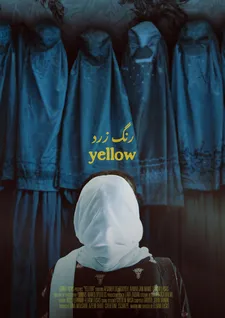 |
| Yellow poster |
“It's an absolute joke,” he agrees. “I was trying to paint that this thing shouldn't actually exist. It's just a black hole in society. But it's everywhere in Kabul. Well, in the outskirts of Kabul. It's taken over, it's almost like a virus has come in, spreading, the blue virus.”
The challenge now, for filmmakers in his position, is figuring out how to keep people paying attention to Afghanistan, because with more and more organisations putting out, it risks disappearing from the world's awareness.
“That's one of the main reasons why I decided to make this film,” he says. “Because with the news cycle, there's things that are the news, things are trending, and then they kind of slide down the priority list. And I feel that Afghanistan, especially Afghan women, are slowly being forgotten. Because don't forget, the defeat of the American empire in Afghanistan is a big signal to the rest of the world that this is a place that no one will ever come back to again. So it's almost like, ‘Alright, keep it down, guys. Don't make too much noise, and we'll just kind of ignore you, like we do North Korea.’
“That's what I fear. That Afghanistan is returning to this thing that’s not in the periphery of the international community. That people just say ‘Alright, you guys have that type of thing, just keep it down, keep it quiet. Don't be too noisy.’ And that's not what I want. I want to make noise. And I want the world to know that the Afghan women need help now more than ever.
“There's girls – I was at my cousins’ last week when I was there – they've been out of school for two and a half years. There's just no school. They've just lost a ton of years of education that they can't get back – years of life. They could have been ten years’ worth more educated than they are now. So that's one of the reasons I made this film. Please don't forget Afghan women. Please look back to Afghanistan and also to the Taliban, and tell them ‘Please engage in the international community and find a way to give women their freedom back.’ Because they're the government now and they have to know how to run a government, whether they like it or not. They have to try and make a government that is fair and equal and provides the basic necessities for its citizens.”
I ask him if there’s anything that people reading this interview can do to help.
“I think the biggest thing is to spread awareness. Write about it, tweet about it, post on Instagram: the schools are closed. Please shout and scream for the international community to push the Taliban regime, the Taliban government, to open schools and give women education. Every voice is so powerful. Even if it's one person, that makes a difference.”
Yellow will screen at the Southbank Centre in London on 25 June.





















